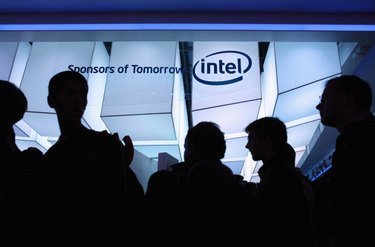
"Celeron" and "Pentium" are the names of two different types of computer chip. This chip is the processor of a computer and performs all the calculations associated with computing. Both chips are products of Intel. The company produced four different versions of Pentium -- Pentium to Pentium 4 -- each more powerful than the last. There are no version numbers for Celeron processors, which were developed later than Pentium processors.
Advancement
Video of the Day
Intel improved its Pentium processor after the first version was released. These improvements got as far as Pentium 4. Intel produced the Celeron design in parallel with Pentium 2. Celeron was not intended to be a replacement for Pentium. The two processors were meant to occupy the marketplace side by side. Celeron processors are cheaper than Pentium processors.
Video of the Day
Celeron Design
The Celeron is a less powerful version of the Pentium. Although the heart of the processor -- the "core" -- is actually the same as the Pentium core, other elements inside the processor case are of lower specifications than the Pentium. These elements are factors such as clock speed. Data moves around a processor as pulses on eight wires. Each wire feeds into a register and the pulses on each wire represents a 1. The absence of a pulse represents a 0. The rate at which this information is moved is dictated by the clock speed. So a slower clock speed means a slower computer. The fastest Celeron chip operates at a clock speed of 2.8 GHz, the fastest Pentium 4 operates at 3.8 GHz.
Pentium Power
The communication path between the processor and other devices is called the bus. The bus speed dictates the rate at which data can enter and leave the processor case. The fastest bus speed for a Celeron processor is 400 MHz and for Pentium it is 1,066 MHz. This means the Pentium processor communicates with other devices of the computer, like keyboard, screen and hard drive, much faster than the Celeron processor. The difference between the clock speed and the bus speed can be explained simply: A higher clock speed means that Pentium thinks faster, and the higher bus speed means that Pentium talks faster.
Memory
A processor needs to make a lot of calculations very quickly. While it is carrying out a calculation, it needs to store certain data for use later on in the program. The place within the processor case where this information is held is called the "cache." This is the memory of the processor, rather than the data storage of the computer. The Pentium outguns the Celeron in cache. The Celeron has about a quarter of the cache capacity of a Pentium 4 with 256 kB, against the Pentium 4's 1 MB. The lack of cache slows down processing, as the chip has to break up its actions so it can clear cache for the next section.